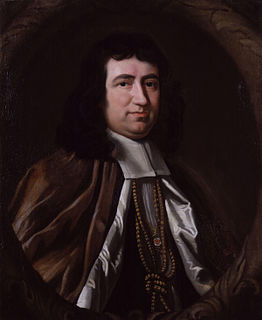Related Research Articles

Arthur Capell, 1st Earl of Essex, PC, also spelled Capel, of Cassiobury House, Watford, Hertfordshire, was an English statesman.

Earl of Essex is a title in the Peerage of England which was first created in the 12th century by King Stephen of England. The title has been recreated eight times from its original inception, beginning with a new first Earl upon each new creation. Possibly the most well-known Earls of Essex were Thomas Cromwell, chief minister to King Henry VIII, and Robert Devereux, 2nd Earl of Essex (1565–1601), a favourite of Queen Elizabeth I who led the Earl of Essex Rebellion in 1601.

Gilbert Burnet was a Scottish philosopher and historian, and Bishop of Salisbury. He was fluent in Dutch, French, Latin, Greek, and Hebrew. Burnet was highly respected as a cleric, a preacher, an academic, a writer and a historian. He was always closely associated with the Whig party, and was one of the few close friends in whom King William III confided.

Earl of Clarendon is a title that has been created twice in British history, in 1661 and 1776.

William Russell, Lord Russell, was an English politician. He was a leading member of the Country Party, forerunners of the Whigs, who during the reign of King Charles II, laid the groundwork for opposition in the House of Commons to the accession of an openly Catholic king in Charles's brother James. This ultimately resulted in Russell's execution for treason, almost two years before Charles died and James acceded to the throne.

Oliver Plunkett, was the Catholic Archbishop of Armagh and Primate of All Ireland who was the last victim of the Popish Plot. He was beatified in 1920 and canonised in 1975, thus becoming the first new Irish saint for almost seven hundred years.
Hugh Speke was an English writer and agitator.

Sir William Capel (c.1446-1515) of Capel Court in the parish of St Bartholomew-by-the-Exchange in the City of London and of Hadham Hall in the parish of Little Hadham, Hertfordshire, served as Lord Mayor of London and as a Member of Parliament for the City of London.

Henry Hyde, 2nd Earl of Clarendon, PC was an English aristocrat and politician. He held high office at the beginning of the reign of his brother-in-law, King James II.

Algernon Capell, 2nd Earl of Essex PC of Cassiobury House, Watford, Hertfordshire, was an English nobleman, a soldier and courtier.
Henry Hyde, 4th Earl of Clarendon and 2nd Earl of Rochester, PC, styled Lord Hyde from 1682 to 1711, was an English Army officer and Tory politician who sat in the English and British House of Commons from 1692 until 1711 when he succeeded to the peerage as Earl of Rochester.

Arthur Capell, 1st Baron Capell, of Hadham Hall and Cassiobury House, Watford, both in Hertfordshire, was an English politician who sat in the House of Commons from 1640 until 1641 when he was raised to the peerage as Baron Capell. He supported the Royalist cause in the Civil War and was executed on the orders of parliament in 1649.

William Capell, 3rd Earl of Essex, was an English courtier and diplomat.

Little Hadham is a village and civil parish in the district of East Hertfordshire, Hertfordshire, England. At the census of 2001 it had a population of 1,081, increasing to 1,153 at the 2011 Census. It is located on the A120 road, which connects it to the nearby town of Bishop's Stortford. The civil parish includes the hamlets of Bury Green, Church End, Cradle End, Green Street and Hadham Ford. Little Hadham, together with the neighbouring village of Much Hadham, are collectively known as The Hadhams.

Richard Graham, 1st Viscount Preston PC was an English diplomat and politician who sat in the House of Commons in two periods between 1675 and 1689. He became a Jacobite conspirator, but his reputation in the Jacobite community suffered when he gave evidence against his co-conspirators in exchange for a pardon.

Elizabeth Capell, Countess of Essex was an English noblewoman, the daughter of Algernon Percy, 10th Earl of Northumberland. She was the wife of Arthur Capell, 1st Earl of Essex. Elizabeth was the subject of a portrait by court painter Sir Peter Lely.
William Jane (1645–1707) was an English academic and clergyman, Regius Professor of Divinity at Oxford from 1680.

Philip Herbert, 7th Earl of Pembroke, 4th Earl of Montgomery KB was an English nobleman and politician who succeeded to the titles and estates of two earldoms on 8 July 1674 on the death of his brother William Herbert, 6th Earl of Pembroke.
Richard Wallop (1616–1697) was an English judge.

Sir Charles Morrison, 1st Baronet of Cashiobury in Watford, Hertfordshire, was an English politician who sat in the House of Commons at various times between 1621 and 1628.
References
- ↑ "Library and Archive Catalogue". Royal Society. Retrieved 15 March 2012.
. Dictionary of National Biography . London: Smith, Elder & Co. 1885–1900.